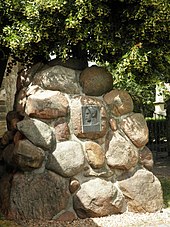Hellwig-Stein (Vippach Castle)
The Hellwig stone in Schloßvippach in Thuringia commemorates a successful battle of a Prussian volunteer corps led by Major Friedrich Hellwig against Polish Uhlans on October 17, 1813.
The monument

The Hellwig stone was inaugurated on October 17, 1913, the 100th anniversary of the battle described below. It stands in Schloßvippach between St. Vitus Church and the Ratskeller. The monument consists of a pyramid of boulders from the corridor of Schloßvippach and neighboring places. On its front facing the location there is a bronze plaque depicting the head of Friedrich von Hellwig. This was made by Heinrich Stegemann from Weimar and the foundry working with the art college there.
The memorial was prepared by a “memorial committee” made up of dignitaries from the community under the direction of the local pastor Georg Rupprecht. The project was supported by the local “Reichsverein” and other associations. It was financed by donations from the population and prominent personalities. Among the donors were Duke Carl Eduard von Sachsen-Coburg and Gotha , General Field Marshal Freiherr von der Goltz and Hellwig's relatives. The boulders were unselfishly brought in by farmers.
Historical background
The then Prussian major Friedrich Hellwig received in May 1813 from Marshal Blücher, with the consent of the king, permission to set up a free corps of 1,300 men "on foot and on horseback" to fight Napoleon's armed forces in the hinterland. The tribe formed a Green Silesian Hussars regiment , came to Mounted police and infantry. After various missions in French-occupied Central Germany, Hellwig learned on October 17, 1813, on the march from Großneuhausen to Sömmerda, that the village and castle of Vippach had been occupied by a squadron of Polish Uhlans. Their officers wanted to hold a ball in the castle that evening. After the Polish field guards were taken by surprise, Hellwig and 55 of his hussars rode a surprise attack on Vippach from two sides. He was able to capture 70 Polish Uhlans with three officers and capture 80 horses. Both were transferred to Sömmerda and successfully defended there by Hellwig's infantry at the gates against attempts at liberation by Polish cavalry.
Better known is “Hellwig's hussar coup” from October 17, 1806 near Eichrodt . After the battle of Jena and Auerstedt, then Lieutenant Friedrich Hellwig and his hussars freed 4,000 Prussians who were under strong French guard on the march from Gotha to Eisenach . A memorial was set there for Hellwig.
For a successful battle in Wanfried against the Westphalian hussars on April 23, 1813, Hellwig was the first Prussian officer to receive the first class of the recently donated Iron Cross .
Hellwig took part in the Wars of Liberation until 1815 until the invasion of Paris , was ennobled in 1826 and ended his military career in 1838 as a Prussian lieutenant general in Silesia.
literature
- Festschrift for the inauguration of the Hellwig Stone in Schloßvippach on October 17, 1913. Written and edited by Georg Rupprecht and other members of the Monument Committee. Print: Richard Wackes, Großrudestedt 1913.
Web links
Coordinates: 51 ° 6 ′ 17.5 ″ N , 11 ° 8 ′ 24 ″ E
